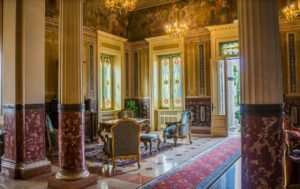Victorian interior design stems from the Industrial Revolution era which has had a major effect on design during the era, improving the affluence of the middle class and allowing them to advance and elevate the decor of their homes.
A lot of people opt for architecture and furnishings that had previously only been available to the aristocracy and the upper class. In these homes, the owners crowded as many pieces of furniture, fabrics, and accessories as possible into a room, due to both an attempt to highlight new cultural interests, prosperity, and status, as well as the fashionable belief that bareness in a room was a sure sign of poor taste.
Colours
The colours largely used for this luxury interior design style are warm and understated with soft colours on grey or cream backgrounds, deep rich walnut, and mahogany browns, black and shades of teal, plum, aubergine, mustardy yellows and golds, burgundy, rust, blue, green, and dusty hues.
Fabrics
Choose from a vast array of period imitation and vintage fabrics and trims from printed floral chintzes and toiles to silk damasks and velvets.
Patterns
Intricate patterns usually cover every surface of a Victorian home. From several wallpapers to luxurious fabrics and oriental rugs, Victorian interior design uses patterns extravagantly through the home. Patterns range from flora and fauna to geometric patterns, stripes, damasks, and more.
Furniture
Furniture is typically lavish. Superfluous excess can often be considered equal with Victorian interior design. Furniture and accessories should be luxurious and range from subtle to huge. Lavishly ornate decorations, china, lace, stained glass, flowers, busts, souvenirs, framed paintings or prints, multi-layered window treatments, richly patterned fabrics, and accessories abundant should be used generously throughout the house. Limits are not part of Victorian interior design.





